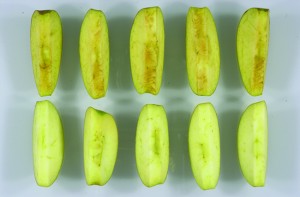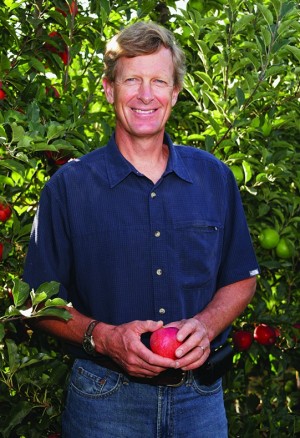AS GM FOODS BECOME MORE COMMON IN THE MARKETPLACE, CONCERNED CONSUMERS AND FOOD INDUSTRY ORGANIZATIONS ARE FIGHTING BACK AGAINST FOOD PRODUCERS AND RESEARCHERS
Text by Lindsay Grummett
The Canadian food industry is no stranger to the headlines. There was the Alberta beef recall back in 2012 and, of course, the legal battle of Michael Schmidt, an Ontario dairy farmer who’s been in and out of court to defend his right to provide raw, rather than pasteurized, milk to consumers. But there’s one subject that seems to capture the consumer’s interest more than the rest: genetically modified (GM) foods or genetically modified organisms (GMO) as they’re also known.
Genetic modification is the use of biotechnology techniques to directly manipulate a plant or animal’s DNA. Brian Ellis, GM food expert and professor emeritus in the Michael Smith Laboratories at the University of British Columbia, explains the technology. “Effectively, you’re introducing new genetic material directly into the plant genome so some traits can be added or deleted from the plant to improve its marketability or ease of production.”
IN THE GARDEN OF GOOD AND EVIL
In Europe, there’s been a forceful backlash to GM foods. Non-governmental organizations (NGOs) passionately promote their anti-GM message and activists have been known to destroy crop trials. The North American reaction has been much tamer although interest is gaining momentum on social media sites and petition platforms like Change.org. The latter allows people to start a petition like mother-daughter duo Linda Cirella and Maya Fischer from British Columbia who, at the time of print, had just under 30,000 supporters for their petition to “Take All GMO Ingredients Out of Girl Guide Cookies.”
Ellis notes that credible GM food research has given no indication that these products have had any deleterious effects, but he’s also quick to say that the scientific connection can be hard to make. “If there are long-term, low-grade effects, we won’t see it and we won’t really be able to connect it to consumption of various GMO food products because we have no means of tracking,” he says.
Ellis says that this is one of the main reasons GM foods are such a hot button issue. “Playing with your food is something that’s viewed as being close to affecting your personal health and well-being,” he explains. “When people are asked about the idea of genetically modifying plants in order to make pharmaceuticals or antibodies, there’s generally far less concern about that because it’s not part of their food system.”
However, as GM food producers and food researchers continue to innovate, they are faced with a growing resistance from uncertain consumers. As a result, companies like Okanagan Specialty Fruits have developed a transparent action plan to push their product toward market approval.
 APPLES TO APPLES
APPLES TO APPLES
Neal Carter, a Canadian fruit grower and president of Okanagan Specialty Fruits, is excited about his innovative non-browning apple. The Arctic Apple, as it is called, is different from typical apples in that it doesn’t brown from biting, cutting or bruising. Apple gene sequences are used to silence the genes that typically allow enzymatic browning to occur.
“Basically, with the Arctic Apple, we’re using an apple gene to turn off another apple gene,” says Carter. “It’s a very simple approach, but the end product of an apple that doesn’t go brown is incredible.”
Carter believes this innovation will be advantageous to producers and retailers.
“This apple is going to allow the people who are making it to get a little bit better margin on it,” says Carter. “It’s going to change the price point which will really influence sales and that’ll drive up apple consumption.”
The ease and convenience of the new, non-browning apple could also improve apple intake, similar to how baby carrots helped carrot consumption, although it should be noted that baby carrots are not a GM product.
In the public sphere, the Arctic Apple has become a polarizing subject. The BC Fruit Growers’ Association requested the suspension of the regulatory approvals process for the apple. The group cites a variety of reasons including concerns with apple testing, the lack of public consultation, cross-pollination with non-GM apple trees as well as worries for the overall apple market.

Canadian Biotechnology Action Network (CBAN) is another organization that’s been very vocal in its opposition to the non-browning apple. “Consumers don’t see it as a necessary product and they just don’t want to eat it,” says CBAN coordinator, Lucy Sharratt.
CBAN is a coalition of organizations that are concerned with the application of genetic engineering in food and farming in Canada. It includes groups like Ecological Farmers of Ontario, Canadian Organic Growers and Greenpeace Canada. “At CBAN, our concern is not just consumer-based. We’re concerned about potential environmental impacts, the question of democracy, the question of rigorous regulation, and social and cultural impacts,” she says.
Even with unrelenting opposition from NGOs and food industry groups, researchers from around the globe continue to come up with innovative ideas that could impact the food chain and alter the way we make use of our food.
THE POWER OF PURPLE
Cathie Martin, a plant biologist at the John Innes Centre in Norwich, England, has been researching the health benefits of purple fruits and vegetables with the help of genetic modification. Approximately 10 years ago, Martin became interested in the nutritional value of anthocyanins, one of the health-promoting compounds that are thought to be present in many types of berries such as blueberries. Martin mused that if she could make a tomato that produced anthocyanins (something the tomato does not do naturally) she could then test and compare the health benefits of red tomatoes against purple.
Her research progressed and she was able to test the purple tomatoes on animals, which produced fascinating and promising results. “Our testing was on mice that are particularly prone to cancer. When they were fed a diet supplemented with purple tomatoes, the average life expectancy of the mouse extended by 30 per cent, which is pretty significant,” says Martin.

New Energy Farms grew the tomatoes in a controlled greenhouse environment following which the seeds and plants were burned to prevent cross-contamination. About 2,000 litres of purple tomato juice was processed by the company and will be sent to cardiovascular subjects in the UK in the coming months.
Although anthocyanins are found in purple fruits like blackberries and blueberries, the introduction of the pigment into tomatoes would provide its benefits to a wider consumer base.
“A lot of people don’t eat those berries because they’re expensive and seasonal,” says Martin. “But here’s something that is not going to cost a huge amount and it’s something you’re already eating in pizza or ketchup.”
If the purple tomatoes continue to prove themselves, Martin says she will try to get regulatory approval in Canada for the tomato juice which, in turn, could lead to approval for the tomato in the fresh market.
The process for GM food approval in Canada is strenuous but Martin says it is all to ensure the safety of the consumer and environment. “Canada has an enlightened perspective on the regulatory approval of genetically modified foods. They’re mostly concerned with the trait that’s engineered and not the way it’s been developed.”
Health Canada’s rigorous approvals process includes an assessment of a number of characteristics including, but not limited to, the composition and nutritional profile of the GM food as well as its non-modified counterpart, its potential for causing allergic reactions or producing new toxins in the food and even the chance of any unintended or secondary effects.
ARCTIC TRANSPARENCY
Consumer concern has yet to stop the Arctic Apple which was first planted in U.S. test orchards more than 10 years ago. Okanagan Specialty Fruits is now seeking deregulated status in both Canada and the United States which would allow it to plant trees without a permit and officially introduce the Arctic Apple into the marketplace.
In the U.S., Carter submitted a 163-page petition to the U.S. Department of Agriculture’s Animal and Plant Health Inspection Service (USDA APHIS) who, in return, developed an Environmental Assessment (EA) and Plant Pest Risk Assessment (PPRA) which was then open to the public for comment. More than 72,000 statements were received during the first comment period.
The Canadian process is similar, with the Arctic Apple review being undertaken by the Canadian Food Inspection Agency and Health Canada. Petitions have been coordinated against the Arctic Apple by groups like GE Free BC and CBAN.
Carter is hoping to win over the undecided consumer with product transparency.
“As a company, we’re small and we don’t have the money for media ads so we’re really active on social media,” he says. “[We’re] just answering and addressing any and every question that comes up, even the ones that say, ‘We hate you, you’re playing God!’”
Ellis says that Okanagan Specialty Fruits’ markedly different approach to GM foods is a benefit to the company, product and industry.
“They’ve made no bones about the fact that they’re bringing a GMO apple into the marketplace. They’ve given it a specific name that the consumer can identify. I think what will be particularly good about this project is consumers will, for the first time, have a choice,” he explains.
MARKET GROWTH
There are more than 81 GM foods that have been approved for consumption in Canada including produce like squash and papaya, yet they haven’t stirred up controversy like the Arctic Apple and often go unnoticed as products of genetic modification.
“Apples are an iconic fruit,” says Carter. “And if the apple business turns GM, even just one apple, now all apples are GM. That’s the assumption.”
Unlike in Europe and other parts of the world, Canadian law does not require mandatory labelling of GM foods. Opposition to labelling GM food items has made it impossible for consumers to know if the food they are eating has been modified genetically.
“Because government and companies have resisted calls for labelling, there’s a very high level of distrust of the governance system and the companies promoting the products,” says Ellis.
CBAN’s Sharratt believes that the lack of GM labelling is influencing consumer choice.
“With no mandatory labelling, every time there’s a news story about a new GM experiment, there are a number of consumers who think that product is already on the market.”
Sharratt believes mandatory labelling will help consumers make informed choices, but also provide food manufacturers and producers with a better understanding of the wants and needs of the consumer.
“There’s a great deal of confusion in the marketplace. Consumers don’t know what products are GM and are making all kinds of assumptions. The food manufacturers and retailers don’t know what those assumptions are and how they’re affecting the market.”
Some food manufacturers have expanded into alternative markets to appease consumers looking for GM-free products. At the start of the year, General Mills announced it would start rolling out a new GM-free Cheerio. The product will be labelled “not made with genetically modified ingredients” although it should be noted that this is not an official accreditation.
Tom Forsythe, the company’s vice president of global communications, addressed the decision on the company’s blog, saying, “We did it because we think consumers may embrace it.”
Although the decision has been positioned as an expansion move, it occurred just over a year after Green America, a not-for-profit organization seeking environmental sustainability, began the campaign “No GMO’s, Cheerios!” General Mills received more than 40,000 messages on its Facebook page related to the campaign.
“Most of these big companies have such a diversity of products in the marketplace that they can have a GMO-free line for consumers,” says Ellis, “although there is clearly a market for the GMO products too because a lot of people just don’t care.”
A recent U.S. study by The NPD Group titled Gauging GMO Awareness and Impact offered insight into consumer choice in the grocery store. Research revealed 67 per cent of all primary grocery shoppers are not willing to pay a higher price for non-GMO foods. There is a subset of grocery shoppers, however, who are aware and concerned about GM foods and willing to pay more. This group accounts for about 11 per cent of all primary shoppers.
Carter feels General Mills’ decision is harmful and slights the efforts of food innovators like himself.
“This is such an inappropriate tool to use in marketing at this time. Particularly when General Mills is making a ton of stuff with GM products and deals with suppliers that supply them with GM-sourced products.”
An organization called the Non-GMO Project has also found emerging business in the unstable food landscape and is offering food verification testing. The North American non-profit connects companies with laboratories that perform third-party PCR analysis on foods to determine whether they harbour any GMO properties.
“Another business opportunity has been created simply as a consequence of the fact that the GMO industry has resisted providing consumers with a mechanism for assuring themselves that they can make a choice,” says Ellis.
TIP OF THE ARCTIC ICEBERG
Anti-GM activists may have caused a stir in the media, but it hasn’t been enough to stop Okanagan Specialty Fruits from moving toward non-regulated status in both Canada and the U.S. Carter says that the review process in Canada is nearly complete, and in the U.S., the second public comment period finished on January 30 and a decision is expected soon. Carter is hopeful in both cases and anticipates the first crop will be harvested in September/October 2015. If everything goes as planned, Carter thinks apples will be just the beginning.
“With citrus greening being such a problem in Florida and the U.S., it’s pretty well assumed that the solution to citrus greening will be biotechnology,” says Carter.
Following apples and citrus, Carter predicts bananas to be the next on the GM agenda although he doesn’t expect it to get any easier for companies producing genetically modified foods.
“The anti-GM guys are going to fight you tooth and nail,” says Carter. “Every new [biotech crop] from now on will go through this kind of rigorous effort of trying to have it stopped.”
But it’s ultimately up to the consumer whether these foods will thrive or fail in the market.
“After regulatory approval, we’ll get the trees in the ground and fruit in the marketplace. That’s what will change everything. It’s really very exciting. It’ll no longer be all these people battling. We think the product is worth the effort and the consumer will decide,” he says.
Further advancements in GM food technology could also help create a less polarized atmosphere. Ellis predicts there will be new techniques arriving on the genetic modification scene in the next five to 10 years that could transform the industry. “Genetic editing” allows the plant genome to be modified in subtle ways that will not leave modification machinery behind in the plant. Ellis says this technique is similar to traditional plant cross-breeding.
“It’s very sophisticated, very targeted and I have a feeling this is where the technology is headed. In a way, that’ll be far more acceptable to people than the current technology which in retrospect looks rather crude. I think a lot of consumers would find that a much more acceptable way forward.”
 Canadian Food Business
Canadian Food Business



